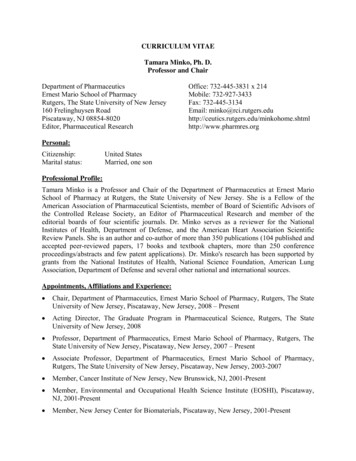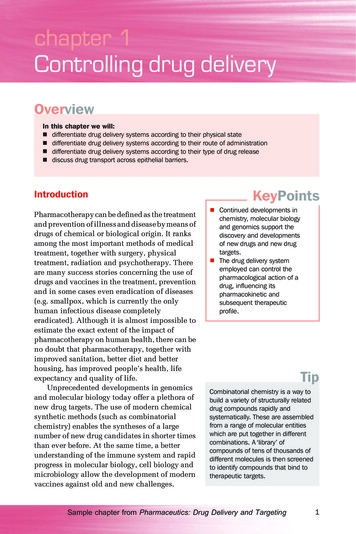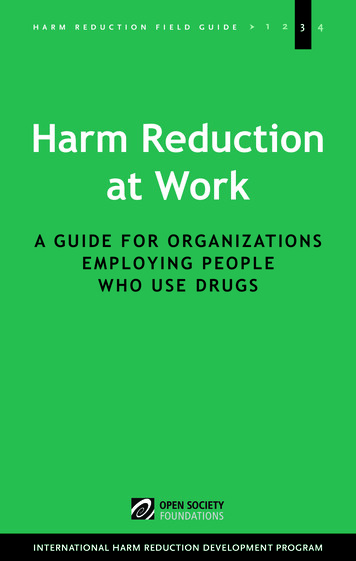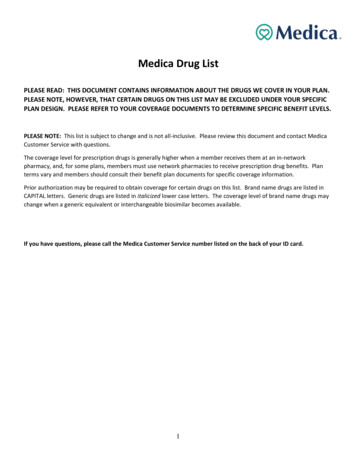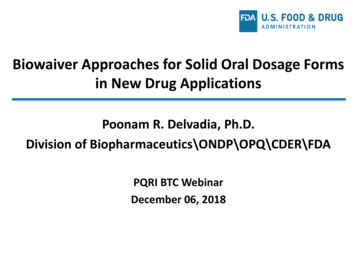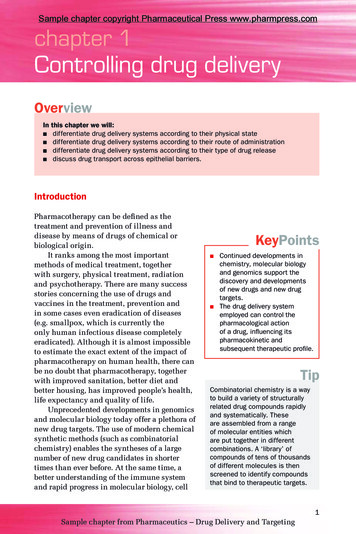
Transcription
Sample chapter copyright Pharmaceutical Press www.pharmpress.comchapter 1Controlling drug deliveryOverviewIn this chapter we will: differentiate drug delivery systems according to their physical state differentiate drug delivery systems according to their route of administration differentiate drug delivery systems according to their type of drug release discuss drug transport across epithelial barriers.IntroductionPharmacotherapy can be defined as thetreatment and prevention of illness anddisease by means of drugs of chemical orbiological origin.It ranks among the most importantmethods of medical treatment, togetherwith surgery, physical treatment, radiationand psychotherapy. There are many successstories concerning the use of drugs andvaccines in the treatment, prevention andin some cases even eradication of diseases(e.g. smallpox, which is currently theonly human infectious disease completelyeradicated). Although it is almost impossibleto estimate the exact extent of the impact ofpharmacotherapy on human health, there canbe no doubt that pharmacotherapy, togetherwith improved sanitation, better diet andbetter housing, has improved people’s health,life expectancy and quality of life.Unprecedented developments in genomicsand molecular biology today offer a plethora ofnew drug targets. The use of modern chemicalsynthetic methods (such as combinatorialchemistry) enables the syntheses of a largenumber of new drug candidates in shortertimes than ever before. At the same time, abetter understanding of the immune systemand rapid progress in molecular biology, cellKeyPoints Continued developments inchemistry, molecular biologyand genomics support thediscovery and developmentsof new drugs and new drugtargets.The drug delivery systememployed can control thepharmacological actionof a drug, influencing itspharmacokinetic andsubsequent therapeutic profile.TipCombinatorial chemistry is a wayto build a variety of structurallyrelated drug compounds rapidlyand systematically. Theseare assembled from a rangeof molecular entities whichare put together in differentcombinations. A ‘library’ ofcompounds of tens of thousandsof different molecules is thenscreened to identify compoundsthat bind to therapeutic targets.1Sample chapter from Pharmaceutics – Drug Delivery and Targeting1
2Pharmaceutics – Drug Delivery and Targetingbiology and microbiology allow the development of modern vaccinesagainst old and new challenges.However, for all these exciting new drug and vaccinecandidates, it is necessary to develop suitable dosage forms ordrug delivery systems to allow the effective, safe and reliableapplication of these bioactive compounds to the patient. It isimportant to realise that the active ingredient (regardless of whetherthis is a small-molecular-weight ‘classical’ drug or a modern‘biopharmaceutical’ drug like a therapeutic peptide, protein orantigen) is just one part of the medicine administered to the patientand it is the formulation of the drug into a dosage form or drugdelivery system that translates drug discovery and pharmacologicalresearch into clinical practice.Indeed the drug delivery systememployed plays a vital role in controlling thepharmacological effect of the drug as it caninfluence the pharmacokinetic profile of theUsually the drug concentrationin the body is determined indrug, the rate of drug release, the site andthe plasma. This is done asduration of drug action and subsequentlythe plasma is comparativelythe side-effect profile. An optimal drugeasy to access and drugdelivery system ensures that the active drugconcentrations can be reliablyis available at the site of action for the correctmeasured using techniquestime and duration. The drug concentrationsuch as high-performance liquidat the appropriate site should be above thechromatography (HPLC). However,the desired site of action for mostminimal effective concentration (MEC)drugs is not the plasma and inand below the minimal toxic concentrationprinciple it would be better to(MTC). This concentration interval is knowndetermine the drug concentrationas the therapeutic range and the concept isat the site of action of the drug.illustrated in Figure 1.1, showing the drugTipMTCPlasma concentrationFigure 1.1 Drugplasma levels after oraladministration of a drugform an immediaterelease dosage form. Thetherapeutic range is theconcentration intervalbetween the minimaleffective concentration(MEC) and the minimaltoxic concentration(MTC). Δt is the timeinterval the drug is in thetherapeutic range.MEC tTimeSample chapter from Pharmaceutics – Drug Delivery and Targeting
Controlling drug delivery3plasma levels after oral administration of a drug from an immediaterelease dosage form.Achieving the desired concentration of a drug is dependenton the frequency of dosing, the drug clearance rates, the route ofadministration and the drug delivery system employed. Within thisbook the terms drug delivery system, dosage form and medicine areused interchangeably. However the term dosage form is often usedto refer to the physical appearance of the medicine whereas theterm delivery system is often used to refer to the way the medicinereleases the drug and delivers it to the bodyor more specifically to the target organ, tissue,cell or even cellular organelle.KeyPointsDifferentiating delivery systemsaccording to their physical state For dosage forms it is common to differentiatethe various types by classifying them accordingto their physical state into gaseous (e.g.anaesthetics), liquid (e.g. solutions, emulsions,suspensions), semisolid (e.g. creams, ointments,gels and pastes) and solid dosage forms (e.g.powders, granules, tablets and capsules). Mostdosage forms contain several phases.Sometimes the phases of a dosage formare of the same state, for example for anemulsion which contains two liquid phases(oil and water). Whilst both phases are liquid,they differ in their physical properties, forexample density and electrical conductivity,and are separated from each other by aninterface. However, more often the dosageform contains phases of different states. Forexample, a suspension contains a liquidand a solid phase. Therefore classificationinto gaseous, liquid, semisolid or soliddosage forms may sometimes appearsomewhat arbitrary. Finally, in thesemultiphase dosage forms usually one ormore phases are dispersed, whilst otherphases are continuous. In a suspensionthe solid phase is dispersed and the liquidphase is continuous, and in an oil-in-wateremulsion the oil phase is dispersed and thewater phase is continuous. In some dosageforms the determination of the type andnumber of phases is not as straightforward. Dosage forms can beclassified according to theirphysical state.Most dosage forms containseveral phases.Systems containing adispersed phase will give riseto physical instability issues.All systems move to a state ofminimum free energy.TipA phase is a volume elementof a system (here the dosageform), separated from othervolume elements of the systemby a phase boundary (interfaceto another phase). The physicalproperties within the phase do notvary, which means that the phaseis physically homogeneous. Fromthe requirement of homogeneitywithin a phase it follows that thenumber of molecules within thephase is large compared to thenumber of molecules forming theinterface between the phases andsurrounding other phases.TipTo understand dosage forms froma physical perspective, try toidentify the number of phases ina dosage form, their state and ifthey are dispersed or continuous.Sample chapter from Pharmaceutics – Drug Delivery and Targeting
4Pharmaceutics – Drug Delivery and TargetingTipsHere are some examples of howdosage forms in their simplestterms can be differentiatedaccording to the state anddispersion of their phases: A drug solution is a one-phasesystem as the dissolveddrug does not fulfil therequirements for a phase.In a solution the molecularlydispersed drug will notseparate out to form largerparticles if the concentrationof the drug is not changed(e.g. by evaporation of thesolvent) and the environmentalconditions (e.g. temperature)are constant. A suspension is a twophase system containing acontinuous liquid phase and adispersed solid phase. An emulsion is a two-phasesystem containing two liquidphases, one dispersed andone continuous. Ointments are generallytwo-phase or multiphasegels, with at least twocontinuous phases (usuallya crystalline or liquidcrystalline surfactant phaseand a lipid phase). Creams additionally containa water phase which may bedispersed (water-in-oil cream)or continuous (oil-in-watercream). Tablets are essentiallycompressed powers, andmight thus be classified ascontaining a solid and gaseouscontinuous phase. Of coursea tablet contains several solidphases, as drug particles areusually present together withother solid phases (e.g. filler,binder, disintegrant, glidantand lubricant particles).For example, the phases of creams can bedifficult to determine, with the presence ofa dispersed water (or oil) phase in additionto several continuous phases (oil, water andsurfactant phases). For liposomal dispersions,the state of the phospholipids used to formthe liposomes will determine if a liposomaldispersion is a suspension (if the lipids arein a crystalline state) or an emulsion (if thelipids are in a fluid, liquid crystalline state).It is important to note that the presenceof a dispersed phase will lead to physicalinstability in the system. For example, inan oil-in-water emulsion, the dispersed oildroplets have a larger interfacial area to thewater than if the droplets had coalesced intoone large continuous phase. This increasedinterfacial area leads to an increased interfacialfree energy, according to the relationship:Gi Agwhere Gi is the interfacial free energy of thesystem, A is the interfacial area between thedispersed phase (here the oil droplets) andthe continuous phase (here the water phase)and g is the interfacial tension betweenthe two phases. The interfacial free energyof the system (here the emulsion) can beminimised by coalescence of the dropletsinto larger droplets and finally into onecontinuous oil phase, as this maximallyreduces the total interfacial area. This isof course undesirable from a formulationviewpoint. Coalescence of droplets in anemulsion is a pharmaceutical instability, butfrom a thermodynamic viewpoint the systemhas been stabilised, as the interfacial freeenergy has been reduced. In practical termsan emulsion is pharmaceutically stabilised byadding emulsifiers to the systems, that eitherlower the interfacial tension (note: if g getssmaller, Gi will get smaller), or that act as aphysical barrier against coalescence. In eithercase, increasing the interfacial area will stillincrease the surface free energy.Sample chapter from Pharmaceutics – Drug Delivery and Targeting
Controlling drug deliveryDifferentiating delivery systemsaccording to their route ofadministrationAnother way of differentiating dosageforms is according to their site or route ofadministration. Drugs can be administereddirectly into the body, through injection orinfusion. This form of drug administration istermed parenteral drug delivery. Dependingon the site of administration into the bodyone can differentiate between intravenous,intramuscular, subcutaneous, intradermaland intraperitoneal administration. Usuallyaqueous solutions are used for intravenousdelivery, but it is also possible that the dosageform contains a dispersed phase (solid orliquid), provided the dispersed particlesare small enough (e.g. smaller than 100–150nm) to avoid embolism. For other routesof parenteral administration the deliverysystems can be aqueous or oily or even solid(the latter dosage forms are termed implants).Drugs can also be administered on to theskin to enter into the body. Mostly semisoliddosage forms are used for this, includingcreams, ointments, gels and pastes. However,liquid dosage forms, such as emulsions, orsolid dosage forms, such as transdermalcontrolled drug delivery systems (patches),can also be used. These will be discussed inmore depth in Chapter 6. It has to be takeninto account, though, that one of the mainfunctions of the skin as an organ is to preventparticles or compounds entering the body,rather than allowing them to be absorbed intothe body. The stratum corneum of the skinforms a formidable barrier against uptakeand thus transdermal delivery is difficultto achieve. Penetration enhancers oftenhave to be added to the delivery system toimprove delivery into or through the skin. Intransdermal controlled drug delivery systemsideally the dosage form controls the uptakeinto the skin (rather than the uptake beingcontrolled by the stratum corneum).5KeyPoints –––––– The various routes ofadministration of a drug intothe body can be generallyclassified into:direct entry into the bodyentry into the body byovercoming the skinentry into the body by overcomingmucosal membranes.The oral route is often themost convenient route fordrug delivery; however, drugsdelivered via this route can bemetabolised by the hepaticfirst-pass effect.TipsParenteral drug deliverySubcutaneous injectionThe needle is inserted into the fattytissue just under the skin. Volumesshould be less than 2.5 mL perinjection site. Insulin is commonlyadministered via this route.Intramuscular injectionInjection into the muscle ispreferred to the subcutaneousroute if larger volumes (typicallyup to 5 mL in appropriate sites)have to be given.Intravenous injectionA needle is inserted directly intoa vein. This is the easiest way togive a precise dose rapidly. Smallvolumes can be given as a singledose whereas larger volumes canbe given by infusion.Intradermal injectionInjection is given into the skin. Thisform of parenteral administrationis used in allergy skin testing.Intraperitoneal injectionInjection through the peritoneum(the thin, transparent membranethat lines the walls of the abdomen).Sample chapter from Pharmaceutics – Drug Delivery and Targeting
6Pharmaceutics – Drug Delivery and TargetingThe most important route of drug administration into the bodyis through mucosal membranes. Mucosal membranes are much lessof a barrier to uptake than the skin and some mucosal membranes(such as the ones in the small intestine) are indeed specialisedsites for absorption. There are many mucosal membranes that canbe used for drug administration. Of the highest importance arethe mucosal membranes of the gastrointestinal tract, allowingoral drug delivery. The suitability and convenience of this routeof delivery make oral dosage forms the most common of all drugdelivery systems. Also the buccal, sublingual, rectal and vaginalmucosa and indeed the lung and nasal mucosal membranes canact as absorption sites. For all of these mucosal membranes dosageforms have been developed, such as buccal and sublingual tablets,suppositories, vaginal rings, inhalers and nasal sprays, to namea few.If drug delivery systems are designed to give a local drug effectand not systemic activity, they can be described as topical deliverysystems. This is the case for many dermal dosage forms.Oral drug deliveryAs stated above, the oral route is the most popular route toadminister drugs. However, some factors should be considered whenlooking to administer drugs via this route. In particular the transittime in the gastrointestinal tract may vary considerably: between patients and within the same patient, with the gastricresidence time being the most variable with the state of the dosage form (liquid dosage forms areemptied out of the stomach faster than solid dosage forms) with the fasted or fed state of the patient.The pH conditions in the gastrointestinal tract also varyconsiderably, from a low pH in the stomach (1.5–2 in the fasted stateto around 5 in the fed state) to a higher pH in the small and largeintestine. The pH in the small intestine varies from 4 to 7, with anaverage value of approximately 6.5. This may affect stability and willinfluence the degree of ionisation of ionisable drugs which in turnwill influence their absorption (unionised forms of drugs are usuallytaken up better than ionised forms of the same drug) and solubility(unionised forms are usually less soluble than ionised forms of thesame drug).First-pass metabolismImportantly, drugs that are taken up into the body through thegastrointestinal mucosa will be transported to the liver via theportal vein before going into general circulation. As the liver isthe main metabolic organ of the body, if the drug is susceptible tometabolic degradation in the liver, this may considerably reduceSample chapter from Pharmaceutics – Drug Delivery and Targeting
Controlling drug deliverythe activity of the drug. This phenomenonis known as the hepatic first-pass effect. Therectal route may also show varying degrees ofthe first-pass effect, while for other routes ofadministration (intravenous, vaginal, nasal,buccal and sublingual) the drug is distributedin the body before reaching the liver, andtherefore for certain drugs these may be thepreferred route of administration. However,whilst the liver is the main metabolic organof the body, metabolism may also take placein the gastrointestinal lumen and indeed inthe mucosal membranes.Differentiating drug delivery systemsaccording to their mechanism ofdrug releaseAnother systematic that can be used todifferentiate drug delivery systems isaccording to the way the drug is released.Broadly, one can differentiate as follows: Immediate release – drug is releasedimmediately after administration. Modified release – drug releaseonly occurs some time after theadministration or for a prolonged periodof time or to a specific target in the body.Modified-release systems can be furtherclassified as:––Delayed release: drug is releasedonly at some point after the initialadministration.––Extended release: prolongs the release toreduce dosing frequency.These terms are also used by thepharmacopoeias and the FDA. Whilstimmediate-release dosage forms aredesigned to give a fast onset of drug action,modifications in drug release are oftendesirable to increase the stability, safetyand efficacy of the drug, to improve thetherapeutic outcome of the drug treatmentand/or to increase patient compliance andconvenience of administration.7TipAfter oral administration first-passmetabolism may occur in theliver and the gut. For example,glyceryl trinitrate is predominantlymetabolised in the liver and istherefore often formulated forsublingual delivery. In contrast,benzylpenicillin and insulin areprimarily metabolised in the gutlumen while orlistat is metabolisedwithin the gastrointestinalmucosal membrane.KeyPoints Dosage forms can control therate of release of a drug and/or the location of release.They can be classified intoimmediate-release andmodified-release dosage forms.The modified-release systemscan be further divided intodelayed-, extended- andtargeted-release systems.Extended-release systemscan be further divided intosustained- and controlledrelease systems.Modifications in drug releaseprofiles can be used toimprove the stability, safety,efficacy and therapeutic profileof a drug.TipsThe various forms of release asdefined by the FDAImmediate releaseAllows the drug to dissolve in thegastrointestinal contents, with nointention of delaying or prolongingthe dissolution or absorption ofthe drug.Sample chapter from Pharmaceutics – Drug Delivery and Targeting
8Pharmaceutics – Drug Delivery and TargetingModified releaseDosage forms whose drug releasecharacteristics of time courseand/or location are chosento accomplish therapeutic orconvenience objectives notoffered by conventional dosageforms such as a solution or animmediate-release dosage form.Modified-release solid oral dosageforms include both delayed- andextended-release drug products.Delayed releaseRelease of a drug (or drugs) ata time other than immediatelyfollowing oral administration.Extended releaseExtended-release products areformulated to make the drugavailable over an extended periodafter ingestion. This allows areduction in dosing frequencycompared to a drug presented asa conventional dosage form (e.g.as a solution or an immediaterelease dosage form).No definition for controlledrelease or targeted releaseis provided by the FDA orpharmacopoeias.KeyPoints Immediate-release deliverysystems give a fast onset ofaction.For a therapeutic action thedrug should be in solution,therefore disintegration of thedosage form and dissolution ofthe drug may have to occur firstdepending on the dosage form.Immediate-release systemsusually release the drug in asingle action following a firstorder kinetics profile.The time of action of the drugis limited to the time that theconcentration of the drug isabove the MEC.Immediate releaseMany dosage forms are designed to releasethe drug immediately or at least as quicklyas possible after administration. This isuseful if a fast onset of action is required fortherapeutic reasons. For example, a tabletcontaining a painkiller should disintegratequickly in the gastrointestinal tract to allow afast uptake into the body.The onset of action is very fast forintravenous injections and infusions andthe pharmacological effect may be seen in amatter of seconds after administration. Thereasons for this are twofold:1. The drug is already in solution, so strictlyspeaking the drug does not have to bereleased from the dosage form at all.2. The drug is directly administered intothe body, so no time is lost due to drugpermeation through the skin or mucosalmembranes, before the target organs canbe reached.In oral solutions the drug is also alreadyreleased and the solution will simply mixwith the gastrointestinal fluids. However,powders and granules need to dissolve firstbefore the drug is released by dissolution.For tablets it is initially necessary that thetablet disintegrates (if it is formed fromcompressed granules this will initiallyhappen to the level of the granules, fromwhich further disintegration into powderparticles and finally drug dissolutionoccurs). For capsules to release their drugcontent it is necessary for the capsuleshell material (for example, gelatin orhydroxypropylmethylcellulose (HPMC))first to disintegrate. Thereafter the drugcan either dissolve from the usually solidpowders or granules in the case of hardgelatin or HPMC capsules or it can bedispersed from the usually liquid, lipophiliccontent of a soft gelatin capsule. Thesetypes of immediate-release dosage formshave an onset of action in the order ofminutes to hours.Sample chapter from Pharmaceutics – Drug Delivery and Targeting
Controlling drug delivery9TipsPlasma concentrationImmediate-release dosage forms usuallyrelease (dissolve or disperse) the drug in aFirst-order kineticssingle action following a first-order kineticsThe rate of the process isprofile. This means the drug is releasedproportional to the concentrationinitially very quickly and then passesof one of the reactants, in ourthrough the mucosal membrane into thecase the drug.body, reaching the highest plasma levelBateman function(termed Cmax) in a comparatively short timeThis function was initially used to(termed t max). Uptake through the mucosaldescribe the concentration of amembranes may be due to passive diffusionradioactive material B that stemsor by receptor-mediated active transportfrom a first-order decay of anotherradioactive material A and thatmechanisms (see section on modifiedin its own right further decays torelease). Once taken up into the body theanother material C. If both decaydrug is distributed throughout the body andprocesses (A B and B C)elimination of the drug by metabolism andfollow first-order kinetics, exactlyexcretion occurs. The elimination processthe same function results as for thealso usually follows first-order kinetics.plasma concentration time curve ofTherefore the plasma levels measured overa drug from an immediate-releaseoral dosage form. The A B decaytime after administration of an immediateis equivalent to the absorptionrelease dosage form (the plasma concentrationprocess and the B C processtime curve) basically are the sum of a firstis equivalent to the eliminationorder absorption and a first-order eliminationprocess.process. The resulting function is known asthe Bateman function. Figure 1.2 shows anidealised plasma concentration versus timeprofile of an immediate-release oral dosage form.An important consideration for immediate-release dosage formsis that the time of action of the drug is limited to the time thatthe concentration of the drug is above the MEC. If the drug has ashort biological half-life, this time interval may be short, requiringFigure 1.2 Idealised plasmaconcentration versus time profileof an immediate-release oraldosage form. The highest drugplasma concentration is termedCmax. The time at which Cmax isreached is termed tmax. The areaunder the plasma concentrationversus time profile is termed AUCand reflects the total amount ofdrug absorbed.CmaxAUCtmaxTimeSample chapter from Pharmaceutics – Drug Delivery and Targeting
10Pharmaceutics – Drug Delivery and Targetingfrequent dosing and potentially leading to low patient complianceand suboptimal therapeutic outcome.The biological half-life of a drug is defined as the time requiredto reduce the plasma concentration by 50% by metabolism orexcretion. Many studies show that a large proportion of patients donot take drugs as directed (for example three times a day), especiallyif the disease is (at least initially) not accompanied by strongsymptoms, for example in the treatment of high blood pressure orglaucoma. To reduce the frequency of drug administration it is oftennot possible simply to increase the dose of an immediate-releasedosage form as the peak plasma concentrations may be too high andlead to unacceptable side-effects. Therefore the drug concentrationwithin the plasma should be above the MEC and below the MTC, i.e.within the therapeutic range (Figure 1.1).KeyPoints Modified-release systemsare designed to influence therelease profile of a drug fromits delivery system.Oral delayed-release systemscan delay release until specificregions of the gastrointestinaltract are reached.Extended release of a drugcan be achieved usingsustained- or controlledrelease drug delivery systems.Controlled-release systemsaim to control the plasmaconcentration of the drugafter administration by variouspossible routes.TipImmediate-release oral deliverysystems can also have polymercoatings. In this case thepolymer may be used to maskan unpleasant taste or odour, tofacilitate swallowing of the drugor to improve identification of themedicine. These coats dissolvequickly in the stomach and do notdelay the release of the drug.Modified releaseDosage forms can be designed to modify therelease of the drug over a given time or afterthe dosage form reaches the required location.Delayed releaseDelayed-release dosage forms can be definedas systems which are formulated to releasethe active ingredient at a time other thanimmediately after administration. Delayedrelease from oral dosage forms can controlwhere the drug is released, e.g. when thedosage form reaches the small intestine(enteric-coated dosage forms) or the colon(colon-specific dosage forms).Delayed-release systems can be used toprotect the drug from degradation in the lowpH environment of the stomach or to protectthe stomach from irritation by the drug. Inthese cases drug release should be delayeduntil the dosage form has reached the smallintestine. Often polymers are used to achievethis aim. The dosage form (for example, atablet or the granules before tableting) can becoated with a suitable polymer. The polymerdissolves as a function of pH, so whenthe dosage forms travel from the low-pHenvironment of the stomach to the higher-pHenvironment of the small intestine, thepolymer coat dissolves and the drug can beSample chapter from Pharmaceutics – Drug Delivery and Targeting
Controlling drug delivery11Plasma concentrationreleased. Once this occurs, the release is again immediate and theresulting plasma concentration versus time curve is similar to theone for immediate-release dosage forms.The development of colon-specific drugs and dosage formsmay be advantageous for the treatment of local and systemicdiseases, including colorectal cancer and Crohn’s disease.Especially for peptide and protein drugs, this form of release mayalso be advantageous for systemic administration given the morefavourable pH conditions in the colon compared to the stomachand the generally lower enzymatic activity compared to the smallintestine.Figure 1.3 shows an idealised plasma concentration versus timeprofile of a delayed-release oral dosage form. Tmax (but not Cmax) isstrongly dependent on the gastric emptying times which, as statedabove, may be quite igure 1.3 Idealised plasmaconcentration versustime profile of a delayedrelease oral dosage formcompared to an immediaterelease dosage form. TmaxIRis the time for maximumplasma concentration ofthe drug released from animmediate-release dosageform and TmaxDR is thetime for maximum plasmaconcentration of the drugreleased from a delayedrelease dosage form.TimetmaxDRExtended releaseExtended-release systems allow for the drug to be released overprolonged time periods. By extending the release profile of a drug,the frequency of dosing can be reduced. For immediate-releasedosage forms the time interval the plasma concentration is in thetherapeutic range of the drug can be quite short. Therefore frequentdosing, with its associated compliance problems, is required. Thisis especially an issue in chronic diseases when patients need totake the medicine for prolonged periods of time, often for the restof their life. Extended release can be achieved using sustained- orcontrolled-release dosage forms.Sample chapter from Pharmace
phases are continuous. In a suspension the solid phase is dispersed and the liquid phase is continuous, and in an oil-in-water emulsion the oil phase is dispersed and the water phase is continuous. In some dosage forms the determination of the type and number of phases is not as straightforward. Dosage forms can be classified according to their





